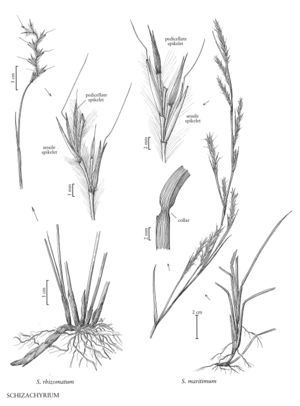Difference between revisions of "Schizachyrium maritimum"
imported>Volume Importer |
imported>Volume Importer |
||
| Line 48: | Line 48: | ||
|publication year= | |publication year= | ||
|special status=Endemic | |special status=Endemic | ||
| − | |source xml=https:// | + | |source xml=https://bitbucket.org/aafc-mbb/fna-data-curation/src/2e0870ddd59836b60bcf96646a41e87ea5a5943a/coarse_grained_fna_xml/V25/V25_1616.xml |
|subfamily=Poaceae subfam. Panicoideae | |subfamily=Poaceae subfam. Panicoideae | ||
|tribe=Poaceae tribe Andropogoneae | |tribe=Poaceae tribe Andropogoneae | ||
Revision as of 21:03, 5 November 2020
Plants often appearing rhizomatous. Culms 35-80 cm, solitary, decumbent, branching at the lower nodes, often rooting from nodes in contact with the soil. Leaves glaucous throughout; sheaths shorter than the internodes, keeled; collars constricted, elongate; ligules 0.5-1 mm; blades 11-142 cm long, 3.5-5.5 mm wide, folded, without a longitudinal stripe of white, spongy tissue. Peduncles 1-6 cm; subtending leaf sheaths 3.2-6.6 cm long, 3-6.5 mm wide; rames 2.5-6.5 cm, flexuous, usually partially exserted, appearing somewhat open; internodes 4-5.5 mm, straight, pubescent for 1/2 - 3/4 of their length, hairs 2.5-6 mm. Sessile spikelets 9-11 mm; calluses 0.3-0.5 mm; hairs to 1 mm; awns 8-13 mm. Pedicels 5-7 mm, as conspicuously villous as the rachis. Pedicellate spikelets 4.5-8.5 mm, staminate, unawned or awned, awns to 3.5 mm. 2n = 40.
Distribution
Fla., Ala., Miss., La.
Discussion
Schizachyrium maritimum is endemic to the south-eastern United States, growing in sandy areas, usually at the ocean waterline but also along roads in low, dune areas, from Louisiana to the Florida panhandle.
The plants often appear rhizomatous because the lower, decumbent portions of the culms are frequently covered by sand. It is an effective sand binder and can withstand frequent inundation by sea water, the constricted collar permitting the blades to sway freely when subjected to wind or wave action.
Selected References
None.
